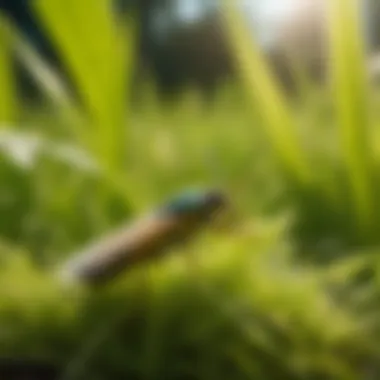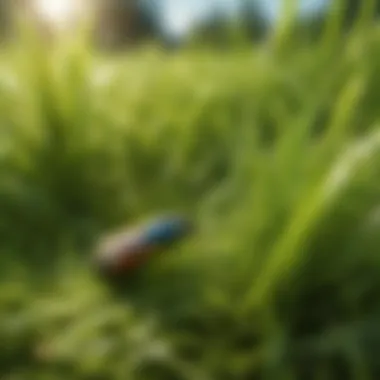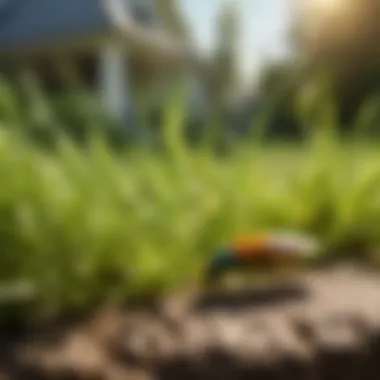Materials:
- Insect-repelling spray (500ml)
- Organic insecticide powder (1kg)
- Protective gloves (2 pairs)
- Garden shears
- Watering can
DIY Steps:
- Identify the type of insects infesting the grass plants by closely examining the damage caused and conducting research on common insect species that target grass.
- Put on protective gloves to shield your hands from any harmful chemicals during the removal process.
- Mix the insect-repelling spray as per the instructions on the packaging and fill the watering can with the solution.
- Carefully spray the affected grass plants, ensuring to cover both the upper and lower surfaces of the leaves to eliminate all insects present.
- Apply the organic insecticide powder around the base of the grass plants to create a protective barrier against future infestations.
- Regularly monitor the grass plants for any signs of insect reinfestation and reapply the repellents as needed.
Technical Aspects:
- Timing: Perform insect control measures during the early morning or late evening when insects are most active.
- Tools: Garden shears for trimming any severely damaged areas of the grass plants.
- Techniques: Ensure thorough coverage of the insect-repelling spray to effectively eradicate all insects on the grass.
DIY Project Process:


- Start by carefully inspecting the grass plants for any signs of insect infestation, such as leaf damage or discoloration.
- Wear protective gloves throughout the process to safeguard your skin from any harmful chemicals.
- Mix and apply the insect-repelling spray with precision, targeting the affected areas of the grass plants.
- Follow up with the application of organic insecticide powder around the base of the plants to prevent future insect attacks.
- Monitor the grass plants regularly and make any necessary adjustments to the insect control measures to maintain a healthy grass ecosystem.
Troubleshooting Tips:


- If you notice persistent insect activity despite treatment, consider consulting with a professional pest control service for specialized assistance.
- Ensure proper ventilation during the application of insecticides to prevent any respiratory issues.
- Thoroughly clean and sanitize all tools and equipment used in the insect control process to avoid cross-contamination.
Introduction


Insects play a crucial role in the delicate balance of ecosystems, and their impact on grass plants is profound. Understanding the intricate relationship between insects and grass is essential for maintaining healthy green spaces. This article delves deep into the nuances of how insects interact with grass plants, exploring their feeding habits, the effects of infestation, and strategies for prevention and control.
Overview of Insects and Grass Plants
Role of Grass in Ecosystem
The Role of Grass in the ecosystem is multifaceted, serving as a primary producer that supports various trophic levels. Grass plays a vital role in soil stabilization, carbon sequestration, and providing habitat for diverse organisms. Its ability to photosynthesize efficiently makes it a cornerstone of many food chains. Despite its resilience, grass is susceptible to damage from insect infestations, which can disrupt the delicate balance of the ecosystem.
Types of Insects Affecting Grass
Various insects pose a threat to the health of grass plants, each with distinct characteristics. Chewing insects, like grasshoppers and beetles, consume grass blade tissues, leading to visible damage. Sucking insects such as aphids and scale insects extract sap from grass, weakening its structure. Boring insects like white grubs and armyworms tunnel into grass stems, causing further harm. Understanding the specific feeding habits of these insect types is crucial for effective pest management strategies.
Significance of Studying Insect Damage on Grass
Impact on Biodiversity
The impact of insect damage on grass extends beyond the individual plant level, affecting biodiversity at larger scales. Grasslands support a wide array of species, and any disruption in the grass ecosystem can have cascading effects on species diversity. Studying insect damage on grass provides insights into how these disturbances influence local biodiversity dynamics, guiding conservation efforts to maintain healthy ecosystems.
Economic Consequences
The economic implications of insect damage on grass are substantial, especially in agricultural and landscaping sectors. Damage to grass plants can result in decreased forage quality, reduced turf aesthetics, and increased maintenance costs. Mitigating insect damage through sustainable practices can lead to long-term cost savings and environmental benefits.
This comprehensive study sheds light on the critical interactions between insects and grass plants, emphasizing the need for proactive pest management strategies and conservation efforts to preserve green spaces for future generations.
Insect Feeding Habits
Chewing Insects
Grasshoppers
Grasshoppers are notorious for their voracious appetite for grass. In this article, we explore how grasshoppers strip grass blades, causing significant damage to lawns and pastures. Their ability to consume large quantities of grass makes them a challenging pest to manage. Despite their destructive nature, grasshoppers serve as bioindicators of ecosystem health due to their sensitivity to environmental changes. Understanding grasshoppers' feeding habits is critical for effective pest control strategies in grassland ecosystems.
Beetles
Beetles, another group of chewing insects, pose a threat to grass plants. Their feeding habits vary among species, with some beetles consuming roots, stems, or leaves of grass. This diversity in feeding preferences contributes to the complexity of managing beetle infestations. While beetles play a role in nutrient cycling and decomposition processes, certain species can cause extensive damage to grass crops and lawns. By identifying key characteristics of beetles and their behaviors, we can develop targeted approaches to protect grass plants from beetle damage.
Sucking Insects
Aphids
Aphids, as sucking insects, feed on grass sap by using specialized mouthparts, piercing the plant tissues to extract nutrients. Their rapid reproductive rate and ability to transmit plant diseases make them a significant concern for grass health. In this article, we delve into the specific aspect of how aphids impact grass plants and explore the implications of aphid infestations on grass ecosystems. Understanding the unique features of aphids and their feeding behaviors is essential for implementing effective management strategies to mitigate aphid damage.
Scale Insects
Scale insects present another challenge to grass plants through their feeding habits. These pests secrete a protective covering that shields them from environmental factors while they feed on grass juices. Despite their small size, scale insects can cause substantial damage to grass by reducing its vigor and vitality. By addressing the key characteristics of scale insects and their impact on grass plants, we can develop sustainable pest control measures to minimize scale insect populations.
Boring Insects
White Grubs
White grubs, known for their boring activities in the soil, feed on grass roots, leading to weakened turf and patches of dead grass. Their distinctive C-shaped bodies and feeding behaviors underground make them a challenge to detect and manage effectively. The unique feature of white grubs lies in their underground feeding tunnels, where they consume root systems, disrupting grass growth. By examining white grubs' characteristics and behaviors, we can implement preventive measures to protect grass plants from severe damage.
Armyworms
Armyworms, with their army-like group feeding behavior, devour large areas of grass within a short period. These pests move in masses, consuming grass foliage and leaving behind devastation in their wake. Their migratory habits pose a threat to grass pastures and lawns, requiring proactive strategies for control. Understanding the unique features of armyworms and their feeding patterns is vital for early detection and intervention to safeguard grass plants from extensive armyworm damage.
Effects of Insect Infestation on Grass
Physical Damage
Reduced Photosynthesis:
Mechanical Injury:
Chemical Damage:
Toxin Secretion:
When discussing chemical damage caused by insect infestation on grass, toxin secretion emerges as a critical aspect. The release of toxins by insects onto grass plants not only impairs their physiological functions but also disrupts their growth and development. In this context, toxin secretion contributes significantly to the deterioration of grass health. Although it may not be immediately visible, the impact of toxins on grass can be profound, leading to long-term consequences. Understanding the mechanism behind toxin secretion and its effects on grass is essential for devising effective strategies to combat insect-induced damage.
Nutrient Depletion:
Exploring the realm of chemical damage, nutrient depletion arises as a fundamental issue faced by grass plants infested by insects. As insects feed on grass foliage, they extract essential nutrients vital for the plant's growth and sustenance. Consequently, nutrient depletion hampers the ability of grass to thrive and compromises its overall health. The depletion of nutrients not only weakens the grass plants but also renders them more susceptible to further damage. By delving into the intricacies of nutrient depletion, this article aims to highlight the significance of addressing this aspect of chemical damage in combating insect infestation on grass.
Secondary Damage:
Fungal Infections:
Weed Infestation:
Preventive Measures
Preventive measures are crucial in mitigating the impact of insects on grass plants. In this article, we delve into the significance of preventive measures, focusing on the specific elements, benefits, and considerations essential for combatting insect damage effectively. Understanding the importance of proactive strategies is key to preserving the health and vitality of grass ecosystems.
Cultural Practices
Cultural practices play a pivotal role in maintaining the health of grass plants and warding off insect infestations. Within this section, we will explore two key cultural practices - proper mowing techniques and adequate fertilization - that contribute significantly to our overall goal.
Proper Mowing Techniques
Proper mowing techniques are a fundamental aspect of grass care that directly impacts the resilience of grass plants against insect damage. By adopting suitable mowing practices, such as mowing at the correct height and frequency, we can promote strong root growth and create a dense turf that is more resistant to pest infestations. The key characteristic of proper mowing techniques lies in ensuring that only one-third of the grass blade is removed during each mowing session, allowing the grass to photosynthesize effectively and maintain optimal health. This method proves to be a popular choice for our article as it not only enhances the appearance of the lawn but also acts as a natural defense mechanism against insect pests. Although proper mowing techniques require time and effort, the advantages of healthier, more robust grass plants far outweigh any minor inconveniences.
Adequate Fertilization
Adequate fertilization is another essential cultural practice that supports the vitality of grass plants and aids in combating insect damage. Proper fertilization provides grass plants with essential nutrients, promoting vigorous growth and enhancing their ability to withstand pest attacks. The key characteristic of adequate fertilization lies in selecting the right type of fertilizer and applying it in the correct amounts at the appropriate times. This practice is a popular choice for our article because it effectively boosts the overall health of grass plants, making them less susceptible to insect infestations. The unique feature of adequate fertilization is its long-term benefits, as properly fertilized lawns exhibit improved resilience and vitality over time. While adequate fertilization requires careful planning and monitoring, the advantages of stronger, healthier grass plants make it a worthwhile investment in the fight against insect damage.
Biological Control
Biological control methods offer an environmentally friendly approach to managing insect populations and protecting grass plants. In this section, we will examine two biocontrol strategies - introduction of predators and use of parasitoids - that contribute to our overarching goal of preserving the health of grass ecosystems.
Introduction of Predators
Introducing natural predators to combat insect pests is a sustainable solution that aligns with our article's focus on eco-friendly pest management. The key characteristic of this method is the release of beneficial organisms, such as ladybugs or lacewings, that feed on harmful insects, keeping their populations in check. The use of predators is a beneficial choice for our article as it allows for targeted pest control without relying on synthetic chemicals. The unique feature of predator introduction is its ability to maintain a natural balance within the ecosystem, providing long-term pest management benefits. While there may be some disadvantages, such as the need for careful species selection and monitoring, the advantages of sustainable pest control and minimal environmental impact make the introduction of predators a valuable tool in grass plant protection.
Use of Parasitoids
Utilizing parasitoids as biological control agents offers a focused and effective way to combat insect pests while minimizing harm to beneficial insects. The key characteristic of using parasitoids is their ability to lay eggs inside pest insects, eventually killing them and reducing pest populations. This method is a popular choice for our article due to its targeted approach, specifically targeting pest species without causing widespread environmental damage. The unique feature of using parasitoids is their ability to reproduce within the pest population, providing ongoing control without continuous human intervention. While there may be certain drawbacks, such as limited effectiveness in large-scale pest outbreaks, the advantages of biocontrol through parasitoids include sustainable pest management and reduced reliance on chemical interventions.
Chemical Control
Chemical control methods serve as a rapid and effective means of managing insect infestations in grass plants. Within this section, we will explore two common forms of chemical control - insecticides and systemic treatments - and their contributions to our overarching goal of safeguarding grass ecosystems from pest damage.
Insecticides
Insecticides are chemical compounds designed to target and eliminate specific insect species that pose a threat to grass plants. The key characteristic of insecticides is their ability to rapidly control insect populations and reduce immediate damage to grass vegetation. This method is a beneficial choice for our article as it provides quick and targeted intervention against severe pest infestations. The unique feature of insecticides is their versatility in application, allowing for customized treatment based on the type and extent of pest infestation. While there are concerns regarding potential environmental impact and the development of insecticide resistance, the advantages of swift pest control and the restoration of grass plant health make insecticides a valuable tool in combating insect damage.
Systemic Treatments
Systemic treatments involve the application of chemicals that are absorbed by grass plants and distributed internally, providing persistent protection against insect pests. The key characteristic of systemic treatments is their ability to target pests that feed on treated vegetation, effectively reducing pest damage over time. This method is a popular choice for our article due to its long-lasting impact on pest populations and minimal risk to non-target organisms. The unique feature of systemic treatments is their ability to protect grass plants from within, creating a natural barrier against insect invaders. While there may be some drawbacks, such as the potential for chemical residue in the environment, the advantages of sustained pest control and minimal application frequency make systemic treatments a valuable asset in preserving the health and integrity of grass ecosystems.
Conclusion
The exploration into the impact of insects on grass plants has unveiled a nuanced understanding of the intricate ecosystem dynamics between these pests and the greenery that they infest. Through dissecting the feeding habits of various harmful insect species and unraveling the multifaceted effects of infestation, we have gleaned valuable insights into the vulnerabilities and resilience of grass plants. This comprehensive study serves as a pivotal guide for landscaping enthusiasts, homeowners, and ecologists alike, shedding light on the importance of sustaining healthy grass habitats amidst the threats posed by invasive insects and their damaging behaviors.
Implications of Combatting Insect Damage on Grass
Sustainable Lawn Management:
Incorporating sustainable lawn management practices emerges as a paramount strategy in mitigating the detrimental effects of insect damage on grass. By adopting eco-friendly approaches such as organic fertilization, integrated pest management, and proper irrigation techniques, maintaining lush green spaces becomes not only a feasible endeavor but also a conscientious one. The key characteristic of sustainable lawn management lies in its long-term benefits, promoting the health of grass plants while preserving the overall ecosystem balance. Homeowners and green space caretakers can benefit from the natural resilience built through sustainable practices, ensuring a vibrant and environmentally friendly landscape for years to come.
Preservation of Green Spaces:
Preservation of green spaces stands at the forefront of combating insect damage on grass, safeguarding the aesthetic appeal, biodiversity, and environmental benefits that these areas provide. The preservation efforts focus on conserving native grass species, promoting organic landscaping methods, and creating wildlife-friendly habitats within green spaces. The unique feature of preservation lies in its conservation-oriented approach, fostering sustainable practices that not only protect grass plants but also enhance the overall ecosystem health. While preservation requires meticulous planning and maintenance, the advantages of fostering green spaces far outweigh the challenges, offering a sanctuary for both nature and community.
Future Research Directions
Integrated Pest Management:
Embracing integrated pest management paves the way for a holistic approach to controlling insect damage on grass plants. By integrating biological, cultural, and chemical control strategies, this method provides a comprehensive framework for sustainable insect management. The key characteristic of integrated pest management lies in its environmentally sensitive tactics, prioritizing natural solutions over harmful chemicals to preserve ecosystem balance. The unique feature of this approach lies in its adaptive nature, evolving to meet the dynamic challenges posed by evolving insect populations while minimizing environmental impact.
Genetic Resistance in Grass:
Harnessing genetic resistance in grass plants offers a promising avenue for establishing resilient green spaces that withstand insect infestation challenges. By breeding grass varieties with inherent resistance to common pests, such as aphids and leafhoppers, researchers and landscape practitioners can cultivate robust turfgrass that thrives in the face of adversity. The key characteristic of genetic resistance lies in its targeted enhancement of plant defenses, reducing the reliance on chemical interventions while boosting the natural immunity of grass species. The unique feature of this genetic approach lies in its potential to revolutionize grass management, fostering sustainable landscapes that require minimal intervention and maintenance.





